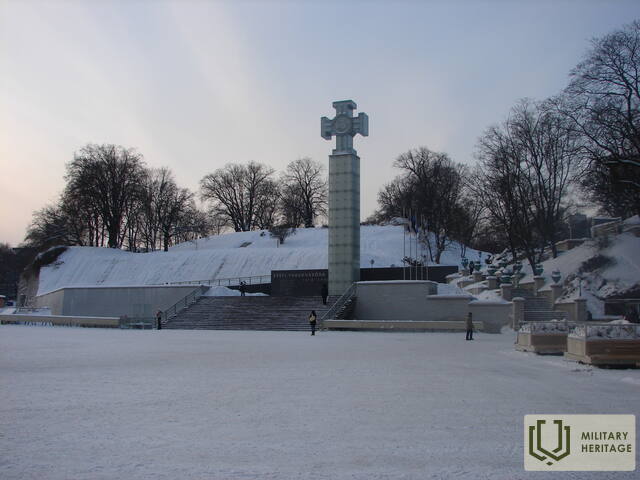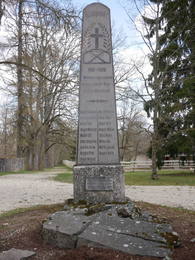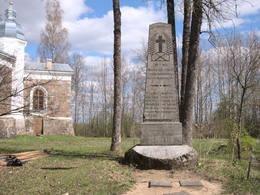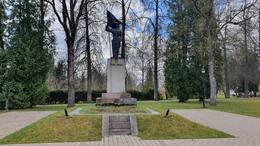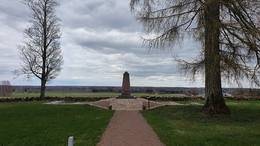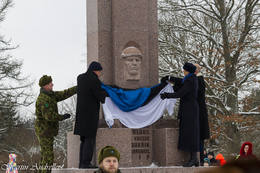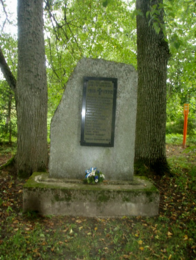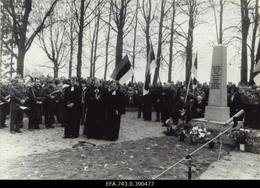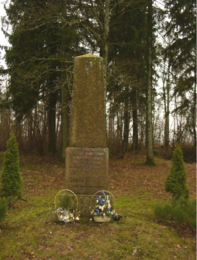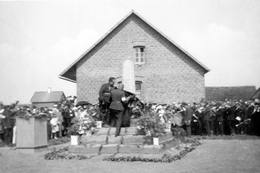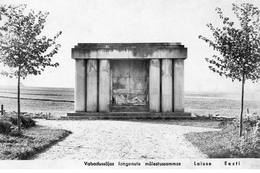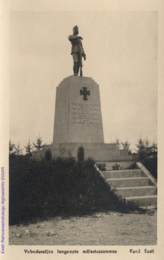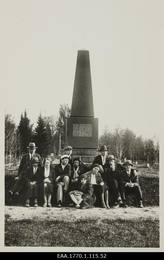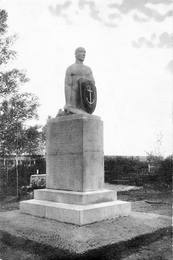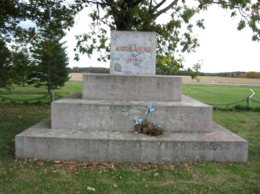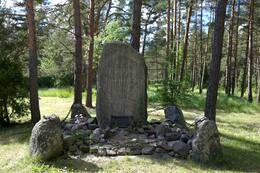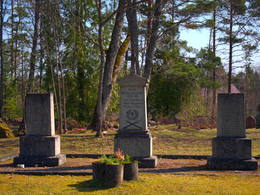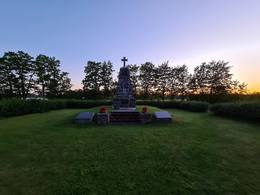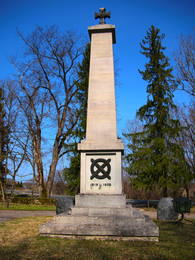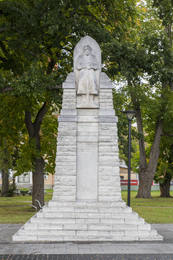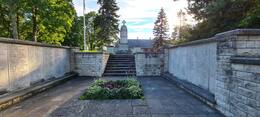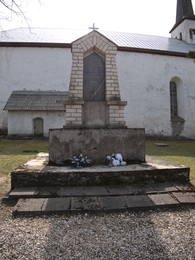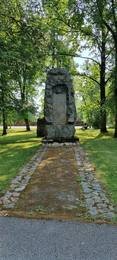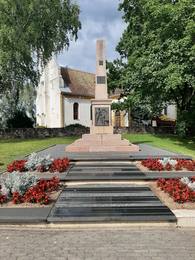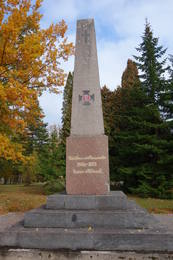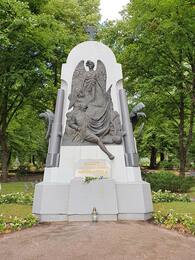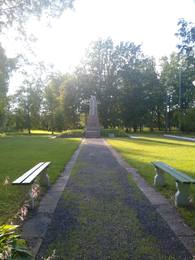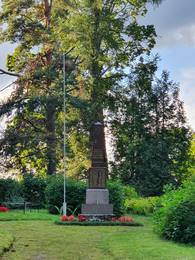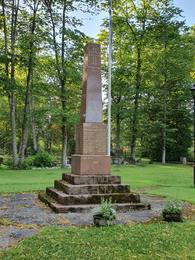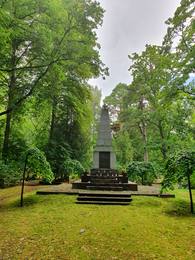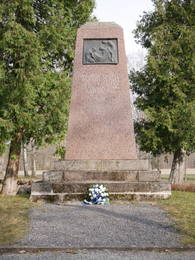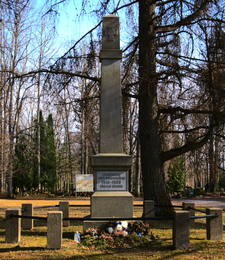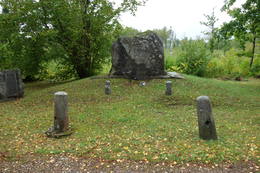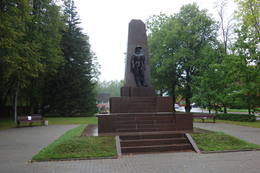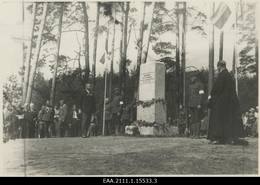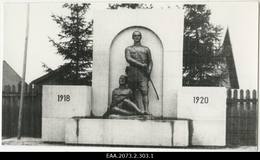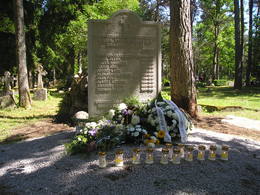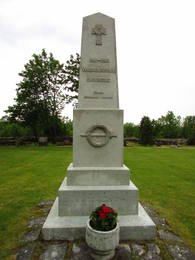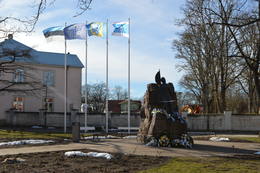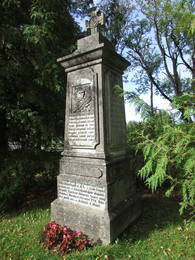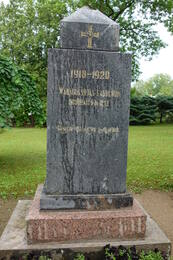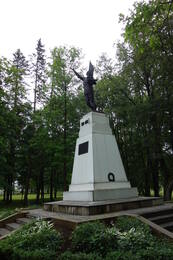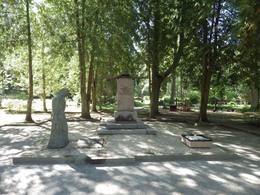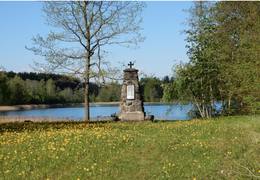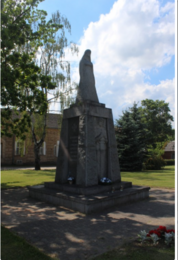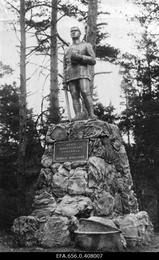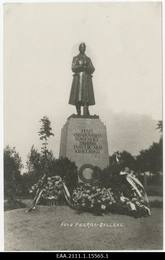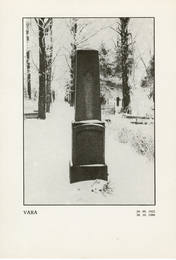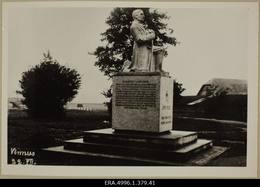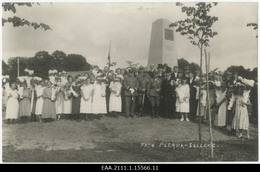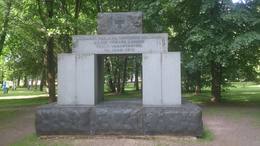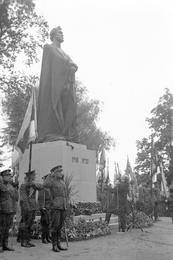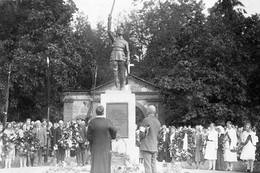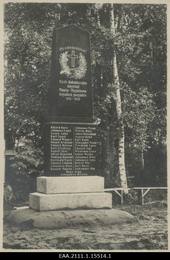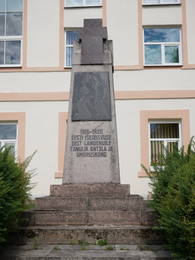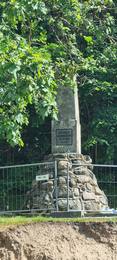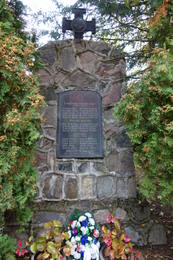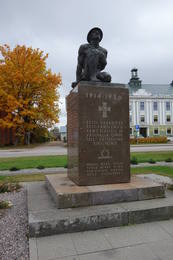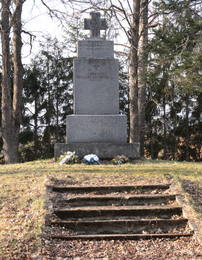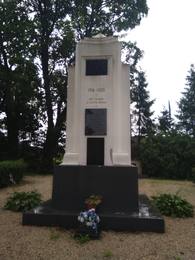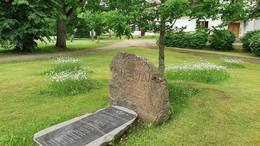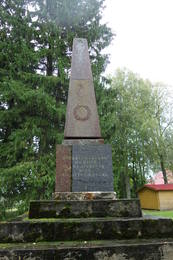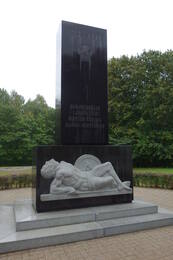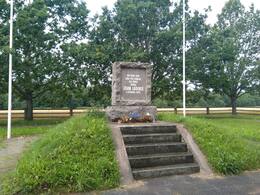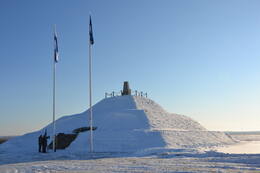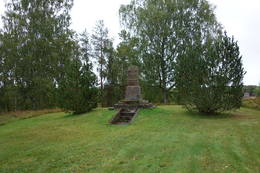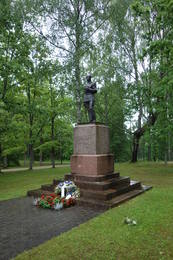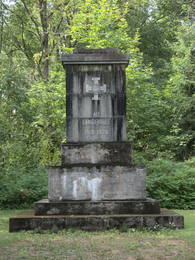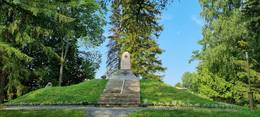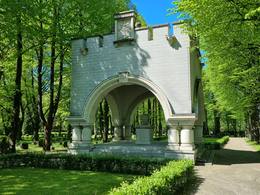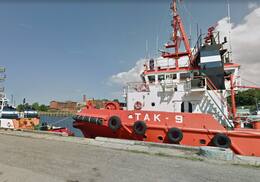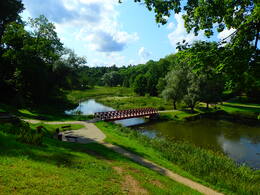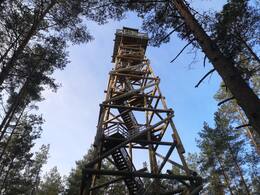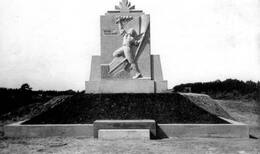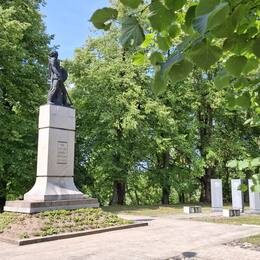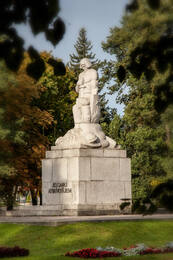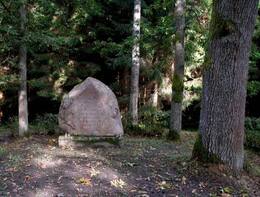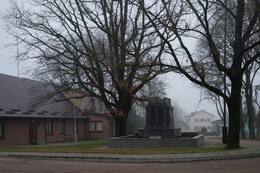Памятники Войны за независимость
I Освободительные войны
По всей Эстонии есть памятники тем, кто погиб, защищая свою Родину в Освободительной войне.
После Первой мировой войны на карте мира появилось множество новых государств. Эстонская Республика была одним из последних, провозгласив независимость 24 февраля 1918 года. Новорожденной республике пришлось отстаивать свой суверенитет в Освободительной войне (28 ноября 1918 года – 2 февраля 1920 года), победа в которой стала одним из высших достижений в истории Эстонии.
Памятники, как правило, довольно просты по форме, но они стали символами свободы Эстонии. Более 170 таких памятников было установлено в межвоенный период. Большинство из них посвящено павшим местным жителям, воинским формированиям или жертвам красного террора. Другие отмечали места боёв или рубежи, на которых было остановлено продвижение противника.
Во время советской оккупации большинство этих памятников свободе были разрушены, осквернены или спрятаны, но они не стерлись из памяти. Как только появилась возможность, началась массовая реставрация памятников: некоторые были восстановлены в первоначальном виде, некоторые переделаны и улучшены. Большинство этих памятников восстановлены сегодня. Кроме того, было открыто 12 новых памятников, посвящённых Войне за независимость.
Связанные объекты
Памятник Освободительной войне в Колга-Яани
Этот памятник возле церкви в Колга-Яани был открыт 19 сентября 1925 года. Он был установлен в память о 17 лютеранах Колга-Яани, погибших во время войны, поскольку памятник в Лалси был посвящен православным, павшим из того же прихода. Это отличие уникально для памятников Освободительной войны. Памятник был снесен 19 июня 1941 года во время первой советской оккупации. 29 мая 1988 года на этом месте был открыт бронзовый бюст Виллема Реймана, священника и одного из важнейших лидеров эстонского национального движения. Памятник Освободительной войне был отреставрирован и вновь открыт год спустя, 28 мая 1989 года, в южной части церковного двора. Это уменьшенная копия первоначального памятника. Части старого памятника находятся перед новым.
Монумент Освободительной войны в Тарвасту
Монумент был открыт 23 июня 1937 года в поселке Мустла. Он был разрушен 18 июня 1941 года во время советской оккупации, а затем вновь открыт 12 июля 1942 года во время немецкой оккупации. В 1948 году он был снова снесен, чтобы в 1990 году появиться уже в новом виде. Памятник был восстановлен в соответствии с оригиналом, лишь с некоторыми незначительными изменениями. Центральным элементом памятника является бронзовый солдат, который держит флаг в одной руке и щит с изображением трех леопардов в другой. Он стоит на гранитном постаменте, который, в свою очередь, опирается на двухступенчатую опору. Стоит упомянуть шлем бронзового солдата: он был смоделирован по образцу знаменитого немецкого Штальхельма, отражающего плачевную ситуацию с поставками амуниции и оружия во время Освободительной войны Эстонии.
Памятник Освободительной войне в Кыпу
Этот памятник, расположенный в небольшом посёлке Кыпу, был открыт 17 сентября 1933 года. Его автором был Альфред Лейус. Как и для других памятников, для его создания использовался коричневый гранит. 17 июня 1941 года памятник был снесён и использован в качестве строительного материала. Он был вновь открыт 23 июня 1989 года. Большой фрагмент первоначального памятника был установлен у обочины дороги, ведущей к нему. На одном из фрагментов, отколотых от оригинала, всё ещё можно разглядеть изображение Креста Свободы.
Памятник битве при Кехре
Сражение при Кехре, состоявшееся 4 января 1919 года, стало первым успешным наступлением бронепоездов и поворотным моментом в Освободительной войне, остановив советское наступление на Таллин. Легенда гласит, что генерал Лайдонер, прибыв на место, лично потребовал разметить место сражения. Этот памятник стал последним, возведённым перед Второй мировой войной. Он так и не был официально открыт: открытие, запланированное на 23 июня 1940 года, было отменено из-за вторжения советских войск. 6,5-метровый памятник был взорван в конце 1944 года (хотя некоторые источники утверждают, что это произошло ещё в 1940 году), а его каменные блоки были использованы для строительства близлежащих дач. Железнодорожная остановка рядом с памятником, которая в годы независимости называлась «Лахингувялья» («Поле битвы»), была переименована советским режимом в 1957 году в Википалу. После восстановления независимости остановка вернула себе своё первоначальное название. Памятник был восстановлен в уменьшенном размере с использованием сохранившихся частей оригинала и открыт 23 июня 2000 года. Восстановленный в первоначальном виде, он был вновь открыт 6 января 2019 года в рамках празднования столетия Эстонской Республики. Колонна украшена рельефным изображением лица солдата и надписью: «Здесь было остановлено наступление противника, и так начался победный марш наших войск 4 января 1919 года».
Памятник Освободительной войне в Каарепере
Этот памятник расположен у дороги Тарту-Йыгева в деревне Каарепере.
Памятник представляет собой камень неправильной формы, стоящий на бетонном основании. Установленная на нём тёмно-серая гранитная плита является оригинальной; остальная часть памятника – копия.
На табличке написано: «Путь, вымощенный вашими могилами, ведет нас к жизни», а под ней изображен Крест Свободы и указаны годы 1918 и 1920.
Памятник был открыт 24 февраля 1933 года и вновь открыт 24 февраля 1990 года.
Памятник битве при Кынну
Этот памятник расположен у дороги Йыгева-Муствеэ, недалеко от небольшого поселка Торма.
По распоряжению руководителя регионального отделения Кайтселийта в Торме Леопольда Крауса, памятник был открыт 27 июля 1930 года. 26 октября 1948 года он был разрушен, а его части захоронены. 14 июля 1988 года части были извлечены и использованы для реставрации памятника, который был вновь открыт 15 октября того же года. Некоторые из оригинальных частей находятся рядом с нынешним памятником.
Памятник Освободительной войне в Садукюле
Этот памятник расположен недалеко от школы в Садукюла, в 15 км от Йыгева.
По заказу компании «Хярьянурме» Союза обороны, памятник отмечает точку, до которой Красная Армия дошла к 1919 году. Открытие состоялось 6 июля 1930 года. После Второй мировой войны памятник был демонтирован, а текст с него снят кузнецом. Все части сохранились, и отреставрированный памятник был вновь открыт 24 июня 1989 года благодаря усилиям местных членов Союза обороны.
На коническом постаменте, поддерживающем обелиск, написано: «Здесь в январе 1919 года храбрость эстонского народа возвестила красной волне, хлынувшей с востока: до этого места и не дальше».
Памятник битве при Лохусуу
Этот памятник расположен в 200 метрах от шоссе Тарту-Йыхви в небольшом посёлке Лохусуу. Он представляет собой обелиск на четырёхступенчатом постаменте. На лицевой стороне обелиска написано: «Эту окропленную кровью землю, где погиб мой брат, я буду защищать до конца своих дней! Битва при Лохусуу в Освободительной войне 14 декабря 1918 года». На обратной стороне обелиска прикреплён текст: «Открыт 26 июля 1931 года. Уничтожен в 1940 году. Открыт вновь 23 июня 1990 года».
Памятник, открытый 26 июля 1931 года, был посвящён павшим в битве при Лохусуу во время Освободительной войны. Советская власть снесла его, а обелиск стал частью памятника Великой Отечественной войне в Авинурме. Памятник был восстановлен как копия и вновь открыт 23 июня 1990 года.
Памятник войне за независимость в Лайузе
Этот памятник находится на кладбище Лайузе в деревне Вилина волости Йыгева.
Он посвящен прихожанам прихода, павшим в Войне за независимость. Он был спроектирован Антоном Старкопфом и открыт 30 августа 1925 года. В июле 1941 года он был снесен, а затем восстановлен во время немецкой оккупации. Снесен в 1954 году.
Мемориал представлял собой храм в греческом стиле. Двухступенчатый фундамент поддерживал шесть каннелированных дорических колонн, несущих массивную коническую плиту. В центре находилось открытое пространство с табличкой с именами погибших и саркофагом с изображением павшего воина.
22 февраля 1998 года на месте прежнего памятника, разрушенного советской властью, был установлен памятный крест по проекту архитектора Ильмара Каннелмяэ. Новый доломитовый крест украшен рельефным изображением Креста Свободы и надписью «Rm 14, 7-9». На табличках у подножия креста с обеих сторон выгравированы имена павших. На левой табличке написано: «ПАВШИМ В ВОЙНЕ ЗА ОСВОБОДИТЕЛЬНОСТЬ», а затем 20 имён. На правой табличке перечислены 24 имени. Текст на другой стороне гласит: «ПАВШИМ В ВОЙНЕ ЗА ОСВОБОДИТЕЛЬНОСТЬ ЭСТОНИИ» и «ЖЕРТВАМ МИРОВОЙ ВОЙНЫ И СОВЕТСКОЙ ОККУПАЦИИ».
Памятник войне за независимость в Пуурмани
Этот памятник расположен недалеко от небольшого городка Пуурмани на дороге Пуурмани-Табивере.
Скульптурный ансамбль Вольдемара Меллика был открыт 26 сентября 1926 года. Он изображал партизана Куперджанова, опирающегося на винтовку на гранитном постаменте. Бронзовая статуя пропала в советское время. Постамент был взорван, а курган, на котором он стоял, сровнен с землей в 1948 году. На его месте был установлен памятник Красной Армии, который в 1970 году был заменён памятником Великой Отечественной войны. Отреставрированная версия первоначального памятника, созданная Кадри Мециком, была вновь открыта 23 июня 1992 года. Вокруг памятника был высажен новый парк, деревья которого названы в честь павших в Освободительной войне и других выдающихся деятелей прихода Курси.
Источники:
Реестр памятников культуры Департамента охраны памятников старины. https://register.muinas.ee/public.php?menuID=monument&action=view&id=27111
Памятник войне за независимость в Паламузе
Этот памятник расположен на Новом кладбище в Паламузе.
Памятник, спроектированный Антоном Старкопфом, был открыт 29 мая 1924 года. Гранитный обелиск был установлен на трёхступенчатом постаменте, на котором внизу были выгравированы имена 25 человек, погибших в Первой мировой войне и 32 – в Войне за независимость. В 1952 году памятник был снесён советскими властями. Новый памятник, открытый 29 мая 1994 года, является точной копией оригинала, созданного Паулем Уйбопуу.
Памятник Войне за независимость в Торме
Этот памятник расположен на кладбище в деревне Ванамыйза, недалеко от небольшого поселка Торма.
Памятник, спроектированный финским архитектором Ивари Анттила, был открыт 17 июня 1923 года. Он изображает коленопреклоненного воина, напоминающего эстонского народного героя Калевипоэга, с мечом в правой руке и щитом в левой. Памятник установлен на коричневом гранитном постаменте. Статуя, обращенная лицом на восток, была повернута лицом на запад в 1940 году, а затем возвращена обратно в 1942 году. Советский режим снёс её в 1948 году. Некоторые части были захоронены. Голова статуи пропала и была обнаружена лишь спустя годы. Точная копия оригинала была открыта 23 июня 1992 года. Первоначальный крест с ромбовидными перекладинами был изменён на Крест Свободы. Сохранившиеся оригинальные части памятника выставлены на кладбище Торма.
Алтарь Победы в Аиду
Алтарь Победы расположен рядом с бывшей молочной фермой на хуторе Вааду в Айду, у дороги Йыгева-Пылтсамаа.
Это памятник Войне за независимость. Он отмечает самый дальний рубеж, который прошёл солдат Красной Армии.
Памятник, спроектированный Эдуардом Ярве, был открыт 23 июня 1929 года. В 1932 году рядом с памятником были посажены два дуба, один из которых сохранился. 4 января 1934 года 2-й пехотный батальон пересадил дуб, привезённый из Айду, на площади у казарм Лембиту в Тарту в честь битвы при Айду.
4 января 1934 года 2-й пехотный батальон выкорчевал один из дубов в Айду и пересадил его на площади перед казармами Лембиту в Тарту в память о битве при Айду. Памятник был взорван в 1940 году и полностью уничтожен в 1965 году. Нынешняя копия оригинала была открыта 23 июня 1989 года.
Монумент Эстонской Освободительной войны на острове Вормси
Памятник представляет собой гранитный валун высотой 2,5 метра, фронтальная сторона которого отполирована. Он расположен посреди сосен у западных ворот церковной ограды в деревне Хулло. Памятник был открыт в 1929 году, эта дата выгравирована на камне. Это один из немногих памятников Освободительной войны Эстонии, переживших советскую оккупацию. Тот факт, что надпись на памятнике написана на шведском языке и на нем нет даты 1918-1920, спас, скорее всего, этот памятник от уничтожения. На памятнике написано: "Жители острова поставили этот камень в 1929 году в честь борцов за свободу". Памятник установлен на основании из булыжников, его ограждают каменные столбы с цепями.
Памятник Освободительной войне в Ныве
Первый памятник был открыт в деревне Ныва 9 сентября 1928 года в память о жителях волости, павших или пропавших без вести в Освободительной войне. Это был кенотаф из известняка Вазалемма с фронтоном, установленный на постаменте и увенчанный латинским крестом. Памятник был разрушен советскими оккупационными войсками незадолго до Второй мировой войны. Он был вновь открыт 6 августа 1989 года. В ходе реставрационных работ к мемориалу были добавлены два кенотафа с именами погибших во Второй мировой войне и жертв коммунизма. На первоначальном памятнике также были высечены имена погибших в Первой мировой войне.
Металлические венки, когда-то возложенные к подножию мемориала, были извлечены с чердака кладбищенской часовни весной 2018 года. На частично сохранившейся ленте одного из венков написано: «…павшим воинам, чтимым памятью верующих Нывы».
Вероятно, это был венок, принесённый на открытие 9 сентября 1928 года прихожанами Нывы. Другой венок – лавровые ветви с серебряной каймой и одним преобладающим цветком – напоминает тот, что изображён на старой фотографии.
Памятник войне за независимость в Ноароотси
Этот памятник, расположенный на кладбище в деревне Хосби, представляет собой обелиск на постаменте, оба из полевых камней, увенчанный чугунным Крестом Свободы. На лицевой стороне обелиска установлена чёрная гранитная табличка с надписями на эстонском и шведском языках в память о павших или пропавших без вести жителях Ноароотси. Памятник был открыт 10 июня 1935 года и уничтожен в 1948 году во время советской оккупации. Крест Свободы, украшавший памятник, позднее был установлен на правой стене притвора бокового входа в церковь Ноароотси. Памятник был вновь открыт 24 июня 1990 года.
Памятник войне за независимость в Нигуле
Расположенный в деревне Нигула волости Ляэне-Нигула, этот памятник, спроектированный Романом Эспенбергом (Хаавамяги), был открыт 14 сентября 1930 года. Обелиск стоит на ступенчатом постаменте, увенчанном ступенчатой пирамидой и бронзовым Крестом Свободы. Передняя часть постамента украшена бронзовым барельефом, изображающим солдата, ухаживающего за раненым товарищем. Он был снесен в 1946 году, но фундамент и бронзовые детали сохранились. Памятник был открыт заново 10 сентября 1989 года. Его доломитовые части являются точными копиями оригинала, в то время как бронзовые части были отреставрированы. На памятнике высечены имена 19 человек, погибших в Освободительной войне и 61 в Первой мировой войне. Кроме того, рядом с памятником находится мемориал погибшим во Второй мировой войне и депортированным.
Памятник Освободительной войне в Хаапсалу
Этот памятник, созданный скульптором Вольдемаром Мелликом, был открыт 1 ноября 1924 года. Стоимость памятника составила 746 000 марок, что было немалой суммой. Часть памятника была профинансирована пожертвованиями, которые Меллик неоднократно переносил. Памятник павшим жителям Ляэнемаа, представляет собой обелиск из доломитового тесаного камня в деревенском стиле, на котором установлен рельеф с изображением солдата, стоящего по стойке смирно. Он был снесен 19 июня 1941 года под руководством председателя местного исполнительного комитета Эвальда Каара. После сноса на месте памятника образовалась клумба с синими, синими и белыми цветами (напоминавшими цвета эстонского флага), которые были быстро вырваны. Зимой 1942 года здесь был установлен памятник, высеченный изо льда. Памятник был вновь открыт 27 ноября 1994 года. Он был полностью отреставрирован по проекту скульптора Вамболы Метса и вновь профинансирован пожертвованиями добрых жителей Хаапсалу.
Монумент Освободительной войны в Кулламаа
Памятник Освободительной войне, выполненный из доломита с острова Сааремаа, был открыт 11 июля 1926 года. Он располагался на площади возле церкви в Кулламаа, где сейчас стоит памятник известному эстонскому композитору Рудольфу Тобиасу. Он был разрушен в 1945 году и вновь открыт 30 сентября 1989 года. В настоящее время памятник находится между бывшим пасторством и церковью. Монумент представляет собой конический обелиск из выступающих и отступающих блоков на ступенчатом основании, обелиск дополняет Крест Свободы. Второй этап постройки мемориала проходил с 1991 по 1999 год: появилась девятиступенчатая лестница, ведущая на платформу, окруженную грубо отделанными стенами из известняка. Он выделяется среди других мемориалов Освободительной войны Эстонии тем, что после его реставрации к мемориалу были добавлены таблички в память о людях, погибших во время Красного террора и Второй мировой войны. Лестница, ведущая к памятнику, окружена стенами, на которых перечислены имена более 300 погибших.
Памятник войне за независимость в Мартне
Этот памятник павшим в Первой мировой войне и Войне за независимость был открыт в деревне Мартна 6 июля 1930 года. Впоследствии он был разрушен (взрывом) 27 августа 1953 года. Он расположен на местном кладбище у церковной ограды. Памятник представляет собой коническую кирпичную статую, напоминающую дверь часовни, установленную на бетонном постаменте с двухступенчатым основанием. Наверху памятника – латинский крест. На памятнике высечены имена восьми воинов, павших в Войне за независимость. Кроме того, на памятнике высечены имена 14 погибших в Первой мировой войне. На задней стороне памятника высечены имена ещё 40 человек. Памятник был вновь открыт 10 октября 1992 года.
Памятник Войне за независимость в Канепи
Этот памятник расположен рядом с церковью Канепи. Он был спроектирован и создан местным скульптором Александром Яннесом и открыт 15 августа 1926 года. Он был высечен из плоского валуна, найденного на церковном лугу. Высота памятника составляет 4,27 метра, он увенчан железным крестом высотой 76 см. Он украшен рельефным изображением шлема, штыка и лавровой ветви, над которыми выгравирована дата 1918–1920 годов (годы Освободительной войны). Над ними выгравирована надпись: «Путник, стоящий здесь, чтобы ты не забыл! Мы погибли, сражаясь за то, чтобы эта земля эстонцев оставалась свободной!» Памятник посвящен памяти павших в Первой мировой войне, Освободительной войне и красном терроре. Он был отреставрирован и вновь открыт 25 сентября 1988 года.
Памятник Освободительной войне в Пылва
Этот памятник расположен рядом с Пылваской церковью. Его автор – скульптор Александр Эллер. Памятник был открыт 29 июля 1928 года, а три мемориальные доски были установлены 2 августа 1936 года. Памятник был разрушен во время советской оккупации в 1946 году, но восстановлен и вновь открыт 29 июля 1989 года. Часть оригинальных каменных блоков, табличка с датой 1918–1920 годов и мемориальные доски с именами погибших в Первой мировой и Освободительной войнах сохранились и были использованы при реставрации памятника.
Памятник Освободительной войне в Ряпине
Этот памятник расположен между церковью и озером в Ряпине. Он был открыт 26 июня 1927 года. Памятник был разобран 27 августа 1945 года, а его части захоронены. 23 февраля 1989 года части памятника были извлечены, и 24 июня 1989 года памятник был вновь открыт, будучи собранным из первоначальных частей. Обелиск, установленный на коричневом гранитном постаменте с тремя ступенями, украшен выгравированным латинским крестом наверху и изображением Креста Свободы посередине.
Пярнуский монумент павшим в Освободительной войне
Монумент павшим в борьбе за независимость Эстонии был открыт в 1922 году на Пярнуском кладбище Алеви, его автор - известный скульптор Амандус Адамсон. Памятник был открыт в 1922 году на Пярнуском кладбище Алеви. В 1929 году неподалеку от своей работы был похоронен и сам скульптор - профессор Адамсон.
15 апреля 1945 года памятник был взорван, он разлетелся на куски, которые затем были захоронены неподалеку. Статуя "Мальчика с венком" была закопана местными старшеклассницами в 175 метрах от памятника. К счастью, могилы солдат остались нетронутыми.
"
Гарнизонное кладбище было отреставрировано в 1987 году, а части памятника (включая статую "Мальчика с венком") были раскопаны в 1988 году. 24 февраля 1989 года верхняя часть памятника, найденная в земле на своем первоначальном месте, была открыта вместе гранитной табличкой с надписью: "1918 1920 / Здесь 16 июля 1922 года был открыт памятник погибшим в войне за независимость / Скульптор Амандус Адамсон / Разрушен в 1945 /24.II 1989 P.M.S.".
Полная реставрация памятника и кладбища проводилась поэтапно. Памятник был вновь открыт 17 июля 1993 года.
Памятник войне за независимость в Лихуле
Этот памятник в Лихуле был спроектирован Ричардом Васардом. Он выполнен из красного гранита, а в центре — серый гранитный крест. Под крестом находится текст: «Павшим в борьбе за свободу 1918–1920 гг.». Краеугольный камень был заложен 19 мая 1935 года, а окончательная установка памятника состоялась 4 августа 1935 года. Памятник был взорван в сентябре 1947 года. Восстановленный памятник был открыт заново 23 июня 1993 года. Сам памятник не имеет мемориальных досок: вместо этого они были установлены по одной на склонах у его основания. Первая из добавленных мемориальных досок содержит имена 26 человек, погибших в Войне за независимость. Мемориальные доски, добавленные позже, посвящены жертвам Второй мировой войны и красного террора. В настоящее время на мемориальных досках увековечены имена более 200 человек из близлежащих муниципалитетов.
Памятник Освободительной войне в Михкли
Этот памятник расположен на сельском кладбище в Михкли в Пярнумаа. Он представляет собой ступенчатый, конический обелиск из полированного тёмно-красного гранита. Верхняя часть лицевой стороны обелиска украшена гравировкой Креста Свободы. Ниже написано: «Сынам прихода Михкли, павшим с честью в Первой мировой войне и Эстонской освободительной войне 1914–1920 годов. Приход Михкли вечно благодарен». Под ним, со всех четырёх сторон обелиска, высечены имена 96 павших. Эти надписи покрыты позолотой. Высота памятника составляет 3,05 метра.
Он был открыт 30 мая 1926 года. В отличие от большинства памятников Войны за независимость, советская власть не успела его разрушить, так как он был спрятан на близлежащем кладбище с помощью местного пастора. Его восстановление оказалось очень простым: захороненный памятник находился в идеальном состоянии и был возвращён на прежнее место совместными усилиями местных жителей в 1988 году.
Памятник Освободительной войне в Пярну-Яагупи
В 1922 году на кладбище в Пярну-Яагупи был открыт памятник воинам из прихода Пярну-Яагупи (ныне волость Пыхья-Пярнумаа), сражавшимся в Первой мировой и Освободительной войнах. Памятник был изготовлен на мраморно-гранитном заводе Юри Валка в Пярну. Он был открыт 22 сентября 1922 года и снесён в 1945 году. К 1 мая 1989 года было собрано 10 362 рубля пожертвований на реставрацию памятника, который был вновь открыт 18 июня 1989 года. Памятник представляет собой многоярусный обелиск на четырёхступенчатом постаменте. Позолоченные контуры на лицевой стороне обелиска изображают Крест Свободы. Под ним находится текст: «Будьте верны до смерти». Нижний постамент обелиска украшен позолоченным списком погибших под названием «Павшим героям Якоби».
Памятник войне за независимость в Аудру
Этот памятник, расположенный на кладбище в Аудру, был создан художником Эрихом Лепсом. Он был открыт 2 июля 1939 года. Памятник был снесён весной 1945 года. Основание памятника осталось нетронутым, а блоки обелиска были сброшены в реку Аудру.
Памятник был вновь открыт 2 июля 1989 года. Памятник изготовлен из доломита, на его обратной стороне выгравированы имена 58 человек, павших в Первой мировой войне, и 46 — в Войне за независимость.
Церковь-памятник эстонским военным и Памятник героям Освободительной войны в Тори
У построенной в 1854 г. церкви в Тори сложное прошлое. В 1944 г. отступающая немецкая армия сожгла церковь до основания. Когда в 1990 году началась реставрация храма, в зале церкви уже росли деревья. Церковь была освящена в 2001 году как мемориал всем жертвам Второй мировой войны и теперь известна как Церковь-памятник эстонским воинам. Церковь также используется в качестве концертного зала.
Памятник Освободительной войне в Тори был спроектирован скульптором Антоном Старкопфом. Он был открыт в 1923 году, но взорван в 1945 году. Памятник был вновь открыт 30 сентября 1998 года. На нем выгравированы имена 73 павших: в наши дни их на 21 больше, чем на оригинале.
Памятник Освободительной войне в Вяндре
Этот памятник был открыт в районе Вяндра 24 июня 1922 года. Его автором был мастер-каменщик Оскар Гольдберг. Памятник был снесён в 1941 году. Предполагается, что ответственным за это был местный звонарь. Памятник был частично восстановлен во время немецкой оккупации: сохранившаяся верхняя часть с изображением Креста Свободы была установлена на кирпичном постаменте. В 1945 году памятник был разобран и вывезен в неизвестном направлении. В конце 1980-х годов он был обнаружен на месте бывшего совхоза в Пяривере. Временный вариант памятника был открыт 24 июня 1989 года. Некоторые источники утверждают, что верхняя часть обелиска с изображением Креста Свободы была найдена в церковном сарае в 2000 году, что позволило окончательно открыть отреставрированный памятник в 2008 году.
Памятник битве при Пунапарги в Войне за независимость
Пунапаргское сражение — стычка между взводами 6-го эстонского пехотного полка и отступающими немецкими оккупационными войсками, произошедшая 23 декабря 1918 года у деревни Пунапарги в Пярнумаа. Это был единственный серьёзный вооружённый конфликт между эстонцами и немцами при отступлении последних из страны. Разведывательный взвод пехотного полка потерял в бою девять человек убитыми и ранеными, трое — ранеными. Похороны павших героев состоялись в Пярну 26 декабря со всеми почестями. В траурной процессии приняли участие более 2000 человек, в том числе отряд Кайтселийта. Немцы потеряли 22 человека убитыми и 30 ранеными. Погибших похоронили на кладбище в Мазсалаце. Памятник в честь Пунапаргского сражения был открыт 12 августа 1934 года. Он был взорван в 1950 году во время советской оккупации. Автор памятника — скульптор Мартин Сакс. Во время Поющей революции 1988 года памятник был восстановлен, а отреставрированная версия открыта 15 октября того же года. На нём изображён Крест Свободы и надпись: «Храбрость приносит победу».
Памятник Освободительной войне в Килинги-Нымме
Этот памятник в городе Килинги-Нымме был открыт 5 июня 1933 года. Статуя солдата была создана скульптором Антоном Старкопфом по образцу Лембито Хансберга, секретаря пожарной команды Килинги-Нымме и ветерана Освободительной войны.
Памятник был взорван рано утром 13 августа 1945 года. Он был вновь открыт 24 июня 2008 года. Он посвящен памяти павших как в Первой мировой войне, так и в Войне за независимость. Примечательно, что бронзовый солдат одет в форму и каску британского образца. Это свидетельствует о широком спектре поставок, использовавшихся во время Войны за независимость благодаря иностранной помощи.
Памятник битве при Реоле
Этот памятник расположен в деревне Тыырасте волости Кастре. Спроектированный Антоном Соболевым, он посвящен битве при Реола, которая стала одним из поворотных моментов Освободительной войны. В ходе битвы, состоявшейся 16–17 января 1919 года, эстонские войска отбили попытку Красной Армии взять Тарту. Памятник был открыт 3 июля 1932 года. После Второй мировой войны он был снесён и закопан. 27 ноября 1988 года памятник, ныне откопанный и отреставрированный Ассоциацией историко-культурного наследия Камбья, был вновь открыт.
Памятник Войне за независимость на кладбище Святого Павла
Этот памятник расположен в северном углу кладбища Святого Павла в Тарту.
Памятник, созданный скульптором Александром Эллером и городским архитектором Арнольдом Маттеусом, изображает двух солдат, созданных Амандусом Адамсоном. Памятник был открыт 11 ноября 1934 года. Во время советской оккупации скульптуры и даты были удалены. 10 октября 2015 года на том же месте был открыт мемориал Войны за независимость, включающий скульптуру «Калев и Линда» Мати Кармина и церемониальную площадь, спроектированную Мати Кармином и Тийтом Труммалом, с дорожками, скамейками и указателями поворота. Памятник установлен на братской могиле 254 солдат, павших в Войне за независимость.
Памятник войне за независимость в Мустьяле
Этот памятник расположен на кладбище Силла в Мустьяле, в 700 метрах от дороги Силла-Кюдема. Его высота (включая основание) составляет 160 см, ширина — 90 см, а глубина — 20 см.
Отреставрированный памятник был спроектирован Мати Кармином и изготовлен каменотесом Волли Саем. Он был открыт 26 июня 2011 года. Памятник посвящён десяти отважным героям из Мустьялы, павшим в Войне за независимость. На памятнике написано:
«НЕТ БОЛЬШЕ ЛЮБВИ, КАК БЫ ЧЕЛОВЕК ДУШУ СВОЮ ПОЛОЖИЛ ЗА ДРУЗЕЙ СВОИХ». ИОАН. 15:13
БЛАГОДАРНЫЕ ЖИТЕЛИ МУСТЯЛЫ
УВАЖАЕМ ГЕРОЕВ ВОЙНЫ ЗА НЕЗАВИСИМОСТЬ"
Памятник войне за независимость в Кихельконне
Этот памятник расположен на кладбище в Кихельконне. Его каменная кладка была выполнена скульптором Михкелем Мунком. Памятник был открыт 29 сентября 1934 года. Памятник был полностью разрушен во время Второй мировой войны. Официальное открытие состоялось 10 июня 1989 года. Нынешний памятник является точной копией оригинала. Он представляет собой обелиск, установленный на трёхступенчатом постаменте. Лицевая сторона обелиска украшена изображением Креста Свободы, под которым написано: «1918-1920 / ЖЕРТВАМ ВОЙНЫ ЗА НЕЗАВИСИМОСТЬ / БЛАГОДАРНЫЙ НАРОД КИХЕЛЬКОННЫ». Постамент украшен барельефом с изображением меча и венка. Высота памятника составляет 3,75 метра. На тыльной стороне обелиска высечены имена 15 павших.
Памятник Освободительной войне в Курессааре
Этот памятник расположен в центре Курессааре на перекрестке улиц Лосси и Ластеаиа.
Он был открыт в память о павших в Освободительной войне (1918–1920). Автором памятника был один из самых известных скульпторов Эстонии Амандус Адамсон, чьей самой известной работой является мемориал «Русалка» в Таллине. Строительство началось в Италии в 1927 году. Памятник был открыт в 1928 году. Позднее его украсили двумя бронзовыми табличками с именами павших и раненых воинов Сааремаа. За время своего существования памятник дважды сносили. Бронзовая скульптура была восстановлена скульптором Матти Вариком по старым фотографиям оригинала.
На лицевой стороне памятника написано: «Павшим в Освободительной войне 1918-1920 годов от благодарного народа Сааремаа».
Памятник войне за независимость в Вальяле
Этот памятник расположен во дворе церкви в Вальяла. Его автор – Антон Ыунапуу. Памятник, установленный в память о воинах из прихода Вальяла, павших в Освободительной войне, был открыт 24 июня 1923 года. Осенью 1944 года (по другим данным, в сентябре 1947 года) он был взорван. Архитектором нового памятника был А. Мянд. Памятник был вновь открыт 23 июня 1993 года.
В первоначальный проект были внесены некоторые изменения. Памятник из доломита представляет собой обелиск, установленный на ступенчатом постаменте, увенчанном карнизом. На нём возвышается доломитовый Крест Свободы.
Монумент Освободительной войны на кладбище Прийметса
Монумент был открыт на этом Валгаском кладбище 11 октября 1925 года. Он находится на месте одного из крупнейших захоронений павших в Освободительной войне и является местом последнего упокоения более 300 человек. К сожалению не все похороненные были опознаны, поэтому на памятнике всего 154 имени. Тем не менее в памятнике упоминаются еще 152 человек, которых не удалось идентифицировать. Памятник был опрокинут в сентябре 1940 года, но люди поставили его на место в июле 1941 года. После Второй мировой войны памятник снова был опрокинут, а затем закопан под землю.
Монумент был открыт заново в том же месте 27 ноября 1988 года. Фрагменты оригинала были смонтированы вместе. Памятник выглядит скромно. Он состоит из ступенчатого основания, увенчанного ступенчатым же обелиском. Используемый материал - серый гранит.
Монумент Освободительной войны в Валге
Монумент в память о борцах за свободу из Южной Эстонии изображает стоящую на вершине высокого постамента статую неизвестного солдата с мечом в ножнах. В одной руке он держит флаг, другая рука вытянута вверх. Первоначальный памятник был открыт в 31-ю годовщину дня рождения лейтенанта Юлиуса Куперьянова 11 октября 1925 года, но был снесен советским режимом в ночь на 21 сентября 1940 года. Заново на своем первоначальном месте на улице Куперьянови в Валге он был открыт уже 16 августа 2013 года. Оригинал памятника был спроектирован в 1925 году Амандусом Адамсоном, который также возглавлял отливку бронзовой скульптуры в Италии. Памятник был восстановлен в натуральную величину скульптором Яаком Соансом. Реставрация была организована Целевой организацией VIKP (Постоянная экпозиция патриотического воспитания в Валге), городским и уездным самоуправлением Валги и Эстонским военным музеем.
Памятник Войне за независимость в Ранну
Этот памятник расположен на кладбище в Ранну. Спроектированный Вольдемаром Мелликом, он был открыт 23 августа 1931 года. В 1949 году советский режим взорвал его. В 1976 году Калев Рааве организовал установку скульптуры «Мать Ранну» на месте прежнего памятника. В 1991 году на стене церкви в Ранну была установлена мемориальная доска в память о жителях этого района, павших в Войне за независимость. В 2014 году, когда обсуждался вопрос о реставрации памятника, фрагменты памятника случайно были обнаружены во время реставрационных работ на кладбище. К сожалению, бронзовое ружьё, каска и фигура солдата на памятнике до сих пор не найдены. Статуя «Мать Ранну» была перенесена, и отреставрированный памятник был вновь открыт на прежнем месте 23 августа 2015 года.
Памятник Войне за независимость в Пангоди
Этот памятник расположен на берегу озера Пангоди в зоне отдыха Государственного центра лесного хозяйства в одноименном селе.
Памятник, спроектированный Вольдемаром Рятсепом, был открыт 23 июня 1934 года. Памятник в форме обелиска был выполнен из полевых камней с крестом-покровителем наверху. Таблички с памятника были сняты в 1940 году, а сам памятник разобран в 1949 и 1950 годах. Восстановленная копия была открыта заново 23 июня 1990 года; на ней были установлены оригинальные гранитные таблички. На табличке на лицевой стороне памятника написано: «Павшим за свободу 1918–1920», за которыми следуют восемь имён и название муниципалитета Кодиярве. На табличке на обратной стороне написано: «Благородное стремление будет вечно сиять сквозь века», и она украшена изображением дубового венка и скрещенных мечей. В 1996 году оригинальный крест был найден в озере Пангоди.
Таблетки оригинальные.
Монумент Освободительной войны в Рынгу
Монумент расположен напротив исторической корчмы "Кывер Кыртс" (построенной где-то между 1807 и 1830 годами) в небольшом поселке Рынгу. Памятник, спроектированный скульптором Александром Эллером, был открыт 30 сентября 1934 года. Бронзовая скульптура, установленная на гранитном основании, изображает героя эстонского эпоса Калевипоэга, защищающего мечом свою мать Линду, которая символизировала Эстонию. Скульптура была разрушена в октябре 1940 года, но затем восстановлена во время немецкой оккупации и вновь открыта 12 октября 1941 года. Памятник был полностью уничтожен в 1948 году. Нынешний памятник, слегка измененный скульптором Виллу Яанисом, был открыт 21 мая 1995 года. Он отличается от оригинала тем, что в верхней части помятника находится статуя Линды, а перед памятником - статуя ее сына Калевипоэга, опирающегося на свой меч.
Памятник войне за независимость в Камбдже
Этот памятник расположен на кладбище в небольшом городке Камбья.
Известный в просторечии как «Камбья Джек», памятник был спроектирован скульптором Александром Эллером и открыт 27 октября 1929 года. Основание памятника было выложено из камней, собранных на сельскохозяйственных угодьях и пастбищах семей погибших и местных жителей Камбьи. Говорят, что статуя солдата была создана по образу старосты фермы Виллеми, депутата Юри Оттаса. Статую снесли в 1940 году. Меч был спрятан местными школьниками прямо там, на склоне холма, но он пропал. Статую установили обратно 12 июля 1942 года, но памятник был полностью снесен 16 мая 1948 года. Отреставрированный памятник с новой бронзовой скульптурой Айвара Эннета был вновь открыт 23 июля 1989 года. Самый известный из солдат, перечисленных на памятнике, — лейтенант Юлиус Куперьянов.
Памятник Освободительной войне в Экси
Этот памятник расположен у дороги Тарту-Йыгева в деревне Волди Тартуского уезда.
Памятник, спроектированный Вольдемаром Мелликом, был открыт 28 июня 1925 года. Чугунная скульптура изображала эстонского солдата, стоящего на страже, в зимней одежде, что символизировало освобождение Экси, произошедшее в это время года. Статуя была снесена в 1945 году, но постамент сохранился. Памятник, отреставрированный скульптором Айрике Танилоо-Богаткин, был вновь открыт 27 августа 1989 года. Нынешняя бронзовая скульптура является точной копией оригинала, но постамент отличается тем, что на нём вырезано изображение меча, а не отдельно стоящего меча, как изначально, на обратной стороне. Памятник окружён дубовой рощей, называемой Дубовым лесом Свободы, которая была посажена в 1925 году.
Памятник Освободительной войне в Куусику
Этот памятник находится на кладбище в деревне Вара. Он был воздвигнут в память о пяти жителях Вары, погибших в Войне за независимость, и открыт 20 сентября 1925 года. В 1950 году он был снесён, но его обломки удалось спрятать. Памятник, отреставрированный из оригинальных фрагментов, был вновь открыт 30 октября 1988 года. Он представляет собой трёхчастный обелиск на постаменте. На лицевой стороне памятника изображён Крест Свободы, под которым рельефными буквами написано: «Павшим в Войне за независимость 1919–1920 гг.», а затем имена пяти павших воинов. На обратной стороне изображён латинский крест и написано: «Нет больше той любви, как если кто положит душу свою за други своя».
Памятник Освободительной войне в Вынну
Этот памятник расположен рядом с церковью в небольшом поселке Вынну.
Посвященный павшим в Первой мировой войне и Войне за независимость, а также жертвам красного террора, он был спроектирован Александром Эллером. Памятник изображает коленопреклоненного солдата на гранитном постаменте. Он был открыт 22 июля 1934 года. В 1945 году он был взорван, постамент закопан, а статуя солдата сброшена в пруд. Памятник был восстановлен из оригинальных фрагментов и вновь открыт 1 сентября 1990 года на своем первоначальном месте. Памятник высотой 4,6 метра представляет собой серо-коричневый гранитный постамент на трехступенчатом основании, поддерживающем скульптуру коленопреклоненного солдата с мечом и шляпой в руках.
Памятник войне за независимость в Пухдже
Этот памятник расположен в парке в Пухья, недалеко от шоссе Тарту-Вильянди. Спроектированный Антоном Старкопфом, он был открыт 5 июля 1925 года в парке в форме сердца, разбитом в 1920–1921 годах местными крестьянами в память о павших в Освободительной войне. Несмотря на приказ сверху, памятник не был взорван в 1950 году, а лишь закопан. В 1988 году по указанию Андруса Сеппа памятник был выкопан и возвращён на прежнее место. Только чугунные мечи на постаменте обелиска пришлось отлить заново. Памятник был вновь открыт 20 августа 1988 года.
Памятник битве при Тяхтвере
Этот памятник, спроектированный Александром Эллером и увековечивающий победу эстонских войск над латышскими стрелками Красной Армии в битве при Тяхтвере 14 января 1919 года, был открыт 3 июля 1932 года. В 1940 году он был снесён, но в том же году восстановлен. После войны советская власть полностью уничтожила памятник и в 1957 году заменила его бюстом Ганса Хайдеманна, деятеля рабочего и профсоюзного движения. Реставрация памятника была предложена Энном Тарто, и он был вновь открыт на прежнем месте 2 июля 2006 года.
Памятник освободителям Южной Эстонии и военное кладбище Раади
Этот памятник расположен на улице Нурме кладбища Раади в Тарту.
Памятник, расположенный на кладбище Тартуского гарнизона, был предложен дважды кавалером Креста Свободы полковником Зигфридом Пиндингом. Каждая сторона памятника представляла один из южных уездов Эстонии, а пять меньших по размеру колонн символизировали города Тарту, Валга, Вильянди, Выру и Петсери. Памятник, созданный Антоном Соболевым и Вольдемаром Мелликом, но оставшийся незавершённым из-за нехватки средств, был открыт 17 октября 1926 года. После Второй мировой войны памятник был разрушен, а его фрагменты захоронены. Оригинальные фрагменты были извлечены в 1988 году и использованы для реставрации памятника, который был вновь открыт 10 июля 1991 года недалеко от своего первоначального места, но до сих пор не достроен.
Памятник Освободительной войне в Тарту
Этот памятник расположен на правом берегу реки Эмайыги у проспекта Вабадузе (между мостами Вабадузе и Каарсилла) в Тарту.
Памятник, спроектированный Амандусом Адамсоном, был открыт 17 сентября 1933 года. Он представлял собой литой бронзовый образ героя эстонского эпоса Калевипоэга, опирающегося на меч. Памятник был демонтирован в 1950 году, но, поскольку люди продолжали приносить цветы и свечи, в 1952 году на этом месте был установлен бюст писателя Фридриха Рейнхольда Крейцвальда. Отреставрированный памятник, созданный скульптором Экке Вяли по старым фотографиям, был открыт 22 июня 2003 года.
Памятник войне за независимость в Маарья-Магдалене
Этот памятник расположен на кладбище в Маарья-Магдалене.
Черный гранитный обелиск с выгравированными позолоченными текстами был открыт 20 августа 1922 года. В 1945 году памятник был демонтирован и захоронен. Обелиск был выкопан 22 июня 1988 года и вновь открыт 31 июля того же года. 23 июня 2020 года, после реставрации, памятник был открыт в третий раз. Лицевая сторона обелиска украшена скрещенными дубовыми ветвями и изображением двух мечей и пистолета. На нем написано: «Честь павшим! Сыновьям прихода Маарья-Магдалена, павшим в Эстонской Освободительной войне 1918–1925 годов». На постаменте высечено 31 имя.
Памятник войне за независимость в Антсла
Памятник Освободительной войне расположен перед зданием ратуши. Этот памятник посвящен мужчинам из поселка Антсла и приходов Вана-Антсла, Ууэ-Антсла, Урвасте и Ваабина, погибшим в Освободительной войне. Его автор – известный эстонский скульптор Юхан Раудсепп. Памятник был открыт 27 сентября 1925 года. Он был снесен в августе 1945 года. Большие обломки были захоронены, а маленькие сброшены в колодец. Он был открыт заново 22 июня 1993 года. Восстановленный памятник является почти точной копией оригинала, уничтоженного советскими войсками. Оригинальная табличка на памятнике была отлита из бронзы, но новая версия выполнена из черного гранита. На ней изображены близкие, приносящие цветы к могилам павших. Список погибших жителей Антсла приведен на обратной стороне памятника.
Памятник битве при Мунамяэ в Освободительной войне
Этот памятник, посвящённый воинам 1-го кавалерийского полка, сражавшимся и погибшим в битве при Мунамяэ во время Освободительной войны, был открыт в 1932 году. 14 июня 1941 года памятник был засыпан песком отдельными фрагментами. Неясно, было ли это сделано в рамках подготовки к сносу или же для предотвращения сноса. Во время немецкой оккупации он был восстановлен путём сборки фрагментов, но в 1944 году был вновь снесён. Памятник был вновь открыт 7 августа 1988 года. На булыжном постаменте установлен каменный блок, напоминающий обелиск. На лицевой стороне памятника изображён Крест Свободы, под которым написано: «Здесь сражался 1-й кавалерийский полк во время Освободительной войны 20 марта 1919 года».
Монумент в память об Освободительной войне в Петсеримаа
Этот памятник в Вярске был построен в соответствии с историческими проектами и фотографиями скульптора Романа Хаавамяэ, созданными в 1938 году, и является уникальным среди восстановленных памятников Войны за независимость в Эстонии. Первоначально памятник должен был быть открыт в парке Свободы в Печорах, но советская оккупация помешала этому дважды, в 1940 и 1944 годах. Все же памятник нашел свое место 80 лет спустя и открыт в Вярске, новом административном центре волости Сетомаа. Он украшен гербом города Печоры, так как памятник изначально финансировался горожанами того времени. Он посвящен многим погибшим – по некоторым оценкам, в боевых действиях в окрестностях Печор погибло около 350 человек. Монумент высотой пять метров увенчан статуей мужчины с мечом и щитом, орнаментированным тремя леопардами .
Памятник Оравской битве
Этот памятник был спроектирован художником Аркадио Лайго и изготовлен мастером-строителем С. Пывватом. Он был открыт в деревне Орава (нынешняя волость Выру) 15 июля 1934 года.
Первоначально табличка на памятнике была уничтожена в 1941 году. Та же участь постигла и весь памятник 31 августа 1945 года. Табличка и камни были захоронены на месте самого памятника.
Плита и большая часть камней были найдены 18 марта 1989 года. Отреставрированный памятник был вновь открыт 15 июля того же года. Помимо павших в Войне за независимость, памятник также увековечивает память павших в Первой мировой войне и жертв красного террора во время Войны за независимость. Памятник представляет собой круглую пирамиду из полевых камней, увенчанную большим чугунным Крестом Свободы. По сравнению с прежним местоположением памятник пришлось перенести примерно на 15 метров, и теперь он стоит рядом с бывшей ратушей в Ораве, в окружении кедров.
Памятник Освободительной войне в Вастселийне
Этот гранитный памятник в небольшом посёлке Вастселийна в Вырумаа представляет собой статую раненого солдата, стоящего на коленях. Памятник был открыт в 1931 году и уничтожен только после Второй мировой войны, в 1948 году, когда солдаты выбросили бронзовую статую в кусты. Свидетельницей этого стала местная жительница Анна Авара, а местные фермеры Август Соэ и Рудольф Палу спрятали статую. Статую выкопали в 1988 году и вернули на прежнее место. Примечательно, что каска солдата была сделана по образцу бельгийской или британской каски того времени. Это свидетельствует о широком спектре вооружения, использовавшегося во время Освободительной войны.
Памятник Освободительной войне в Выру
Памятник Освободительной войне в Выру расположен на городском кладбище Выру. На кладбище в Выру находятся 42 могилы солдат, павших в Освободительной войне. Имена 36 из них известны. Территория, отведенная для них, была огорожена цепными столбиками со стороны старого кладбища в 1928 году, а в центре был установлен памятник. Памятник был открыт 23 июня 1938 года. Он венчает трехступенчатый цоколь, верхняя часть которого образует две ступени, увенчанные Крестом Свободы. Памятник был снесен в 1946 году и вновь открыт 23 июня 1988 года. Это был второй памятник Освободительной войне в Эстонии, публично открытый на официальной церемонии. Отреставрированный памятник был изготовлен из бетона и значительно шире оригинала. Не все в Выру были рады реставрации памятника: за месяц до его открытия кладбище подверглось акту вандализма, были повреждены надгробия и осквернены могилы павших.
Памятник Освободительной войне в Пилиствере
Этот памятник расположен недалеко от церкви в Пилиствере и посвящен 58 мужчинам из прихода, павшим в Освободительной войне. Он был создан скульптором Александром Эллером. Памятник был открыт 26 июля 1931 года. 19 августа 1940 года памятник был снесен по приказу советской власти, но вновь открыт 12 июля 1942 года. Первоначальный памятник представлял собой бронзовую статую солдата. Незадолго до прихода немецких войск в 1941 году памятник был разобран и перевезен в Вильянди. Его бронзовая статуя пропала по неизвестным причинам, и памятник пришлось восстанавливать без нее во время немецкой оккупации. Он был снесен во второй раз осенью 1945 года. Памятник был открыт в третий раз 28 июля 1991 года. Поскольку бронзовая статуя до сих пор не обнаружена, ее заменили гранитным Крестом Свободы. На оригинальных мемориальных досках выгравированы имена 54 погибших.
Памятник Освободительной войне в Кярстне
Памятник в память о битве при Кярстне и 18 погибших в ней солдатах был открыт 28 августа 1928 года. Предполагается, что автором памятника был Леонхард Пруул, тогдашний руководитель отделения скульптуры Государственной школы искусств и ремёсел. Каждая сторона памятника украшена барельефом с изображением батальной сцены Освободительной войны. На лицевой стороне памятника написано: «Досюда и ни шагу дальше! Героям, сражавшимся в боях при Кярстне за свободу Эстонии. Большая Кярстна». Как и многие памятники, посвящённые Освободительной войне, этот памятник был снесён в 1941 году. Постамент, уцелевший после первого взрыва, был окончательно разрушен 31 октября 1944 года. Памятник был вновь открыт в 1989 году.
Монумент Освободительной войны в Сууре-Яани
Монумент по проекту Амандуса Адамсона был открыт на кладбище Сууре-Яани 24 июня 1926 года. На нем изображен древний эстонский вождь Лембиту, раненый, но все еще держащий свой меч высоко над головой. Памятник был снесен дважды: в 1941 году и в 1950 году. Он был восстановлен и открыт заново 23 июня 1990 года. После первого сноса памятника бронзовая статуя самого Лембиту была помещена в сарай, принадлежащий местному исполкому, но возвращена на свое первоначальное место во время немецкой оккупации. После второго сноса памятника в 1950 году поврежденная бронзовая скульптура, у которой теперь не хватает одной руки, была передана музею Вильянди. Новая бронзовая скульптура была отлита для вновь открытого памятника в 1990 году.
Памятник Освободительной войне в Ыйсу
Этот памятник, расположенный на территории мызы Ыйсу, представляет собой необработанный булыжник коричневатого цвета высотой около метра, на котором высечены годы 1918–1920. Изготовитель и дата установки неизвестны. Оригинал памятника сохранился. В 1940 году он был закопан учениками молочного техникума в Ыйсу, скрывая его от советских властей. Памятник был раскопан и установлен заново во время немецкой оккупации, а осенью 1944 года снова захоронен. Памятник был вновь открыт 27 октября 1988 года.
Памятник Войне за независимость в Халлисте
Этот памятник в деревне Порнузе представляет собой обелиск на постаменте, установленном на четырёхступенчатом основании. В качестве материала был использован красновато-коричневый гранит. В верхней части лицевой стороны обелиска выгравировано изображение Креста Свободы. Он был открыт 29 октября 1933 года. Он был взорван в 1945 году во время советской оккупации. Отреставрированный памятник был впервые открыт 24 июня 1991 года. Позднее было решено восстановить обелиск в соответствии с оригиналом. Он был открыт во второй раз 17 августа 1996 года. Нынешний памятник является точной копией оригинала, который был настолько прочным, что взрыв не разрушил его полностью. Оставшаяся часть была оставлена нетронутой во время реставрации. Хорошо видно, какая часть является оригинальной, а какая восстановленной. Это уникальное различие было достигнуто благодаря использованию серого гранита для контраста. Дорога, ведущая к памятнику, с обеих сторон обрамлена обломками оригинала. На табличках, установленных по бокам памятника, выгравированы имена 48 человек, погибших в Войне за независимость.
Памятник войне за независимость в Каркси-Нуйа
Этот памятник в Каркси-Нуйа был открыт 23 июня 1936 года. Он был снесён 16 июня 1941 года во время советской оккупации. Памятник был вновь открыт 6 сентября 2008 года на новом месте перед кладбищем Рахумяэ, в полукилометре от прежнего. Изменение местоположения было обусловлено тем, что на прежнем месте теперь находится промышленная зона. Памятник пришлось восстанавливать исключительно по старым фотографиям, поскольку от оригинала ничего не осталось. Для его создания были использованы два высоких гранитных блока высотой 3 метра. Переднюю часть памятника украшает белый барельеф работы Ханнеса Старкопфа с изображением павшего солдата.
Место рождения генерала Йохана Лайдонера
Жилой дом на хуторе Раба в деревне Вардья, где родился генерал Лайдонер, не сохранился. Считается, что он был разрушен уже до Второй мировой войны, так как на его месте в 1937 году был установлен памятный камень. Памятник был снесен в 1940 году, а восстановлен в 1990 году. В последние годы люди регулярно ставят свечи на старой усадьбе в день рождения генерала, 12 февраля.
Памятник битве при Паю
Бой у мызы Паю произошел 31 января 1919 года во время Освободительной войны Эстонии. В этом бою сошлись воины Тартуско-Валгаской группы Эстонской Народной Армии и красные латышские стрелки. В результате сражения эстонцы получили контроль над стратегически важным железнодорожным узлом - городом Валга. Юлиус Куперьянов, возглавлявший атаку эстонцев, был смертельно ранен в бою.
Этот памятник был спроектирован архитектором Георгом Сааром. Была организована народная кампания по сбору средств на строительство памятника. 12 июня 1938 года генерал Йохан Лайдонер заложил краеугольный камень основания памятника. Строительство основания было завершено в 1940 году, но сам памятник так и не был открыт из-за советской оккупации. Спустя 75 лет после битвы при Паю, 30 января 1994 года президент Эстонии Леннарт Мери наконец-то открыл памятник.
Памятник войне за независимость в Таагепере
Этот памятник расположен в деревне Ала волости Тырва, на территории бывшей мызы Таагепера. Он представляет собой обелиск, первоначально установленный в виде плиты на лестнице, со ступенчатым постаментом (первоначально с тремя ступенями), установленным на ступенчатом основании. На лицевой стороне обелиска выгравирована надпись «ЧЕСТЬ ПАВШИМ»; под ней – изображение Креста Свободы и даты 1918–1920 годов. Памятник был создан тырваским каменщиком Рихардом Тоомингом. Памятник был открыт 2 сентября 1934 года.
Он был снесен в октябре 1940 года.
Спустя годы каменщику Элмару Клингу передали постамент с именами павших. Он связался с местными жителями и получил заказ на реставрацию памятника. Памятник был вновь открыт 12 мая 1990 года.
Памятник Освободительной войне в Тырве
Этот памятник расположен в парке рядом с Тырваской гимназией. Автором проекта памятника был Александр Эллер, который также изготовил бронзовую статую. Каменную кладку выполнил каменщик Рихард Тоомингас. Памятник был открыт в Тырваском городском парке 14 октября 1928 года. Говорят, что во время советской оккупации группа местных молодых людей решила спасти памятник и 24 сентября 1940 года спрятала его бронзовую статую в реке Ыхне. Судьба статуи неизвестна, поскольку в ходе реставрации была изготовлена её копия по старым фотографиям. Памятник был вновь открыт 23 июня 1990 года.
Статую в разговорной речи называют Джуку или Джек.
Памятник Освободительной войне в Люллемяэ
Памятник Освободительной войне расположен на кладбище Люллемяэ. Памятник был спроектирован инженером-геодезистом Георгом Сааром и изготовлен предпринимателем Яаном Кыйвом и каменщиком Яаном Нылвандом. Он был открыт 23 июня 1936 года. Он представляет собой каменный блок на сером гранитном постаменте, возвышающемся над ступенчатым основанием. Лицевая сторона памятника украшена барельефом Креста Свободы и надписью: «Честь павшим в 1919–1920 годах». На задней стороне выгравированы имена 25 павших.
В 1941 году памятник был снесен и вновь открыт 12 июля 1942 года во время немецкой оккупации. 10 декабря 1944 года памятник был взорван на куски. Обломки, образовавшиеся после взрыва, были разбросаны по территории, пока в 1982 году их не свалили в близлежащие кусты. Основание и ступени памятника сохранились. Отреставрированный памятник был открыт 23 июня 1992 года.
Памятник Освободительной войне в Отепя
Этот памятник расположен недалеко от церкви в Отепя.
Проект памятника разработал Вольдемар Меллик, а изготовил его каменщик Пеэтер Вебер. Памятник был открыт 10 июня 1928 года. 17 июня 1950 года он был снесён, а его части захоронены. Обелиск был обнаружен 3 августа 1988 года.
Проект нового памятника был разработан Р. Унтом. Памятник был вновь открыт 15 июля 1989 года. Обелиск взят с оригинала; остальная часть памятника представляет собой точную копию. На оригинале были выгравированы имена 54 павших, но по неизвестным причинам сейчас на нём только 37 имён. Памятник стоит на ступенчатом основании на вершине невысокого холма. Памятник представляет собой обелиск со ступенчатым, а не острым, остриём. Он увенчан Крестом Свободы.
Кладбище Сил Обороны
Кладбище Сил обороны, основанное в 1887 году, является местом захоронения солдат разных национальностей, погибших в Эстонии. Здесь было захоронено около 5000 человек. Во время Освободительной войны на кладбище были похоронены 440 эстонских солдат, 130 белогвардейцев, сражавшихся с Красной Армией, и 150 военнопленных Красной Армии, умерших от болезней. Мемориал павшим в Освободительной войне был спроектирован архитектором Эдгаром Йоханом Куузиком и открыт 21 октября 1928 года. В межвоенный период это была единственная могила Неизвестного солдата в Эстонии и важный памятник павшим героям. Памятник был снесён советской властью в 1950 году. Он был восстановлен как точная копия и вновь открыт 27 ноября 2012 года.
Бронзовый солдат, первоначально называвшийся Памятником освободителям Таллина, был спроектирован Энном Роосом и Арнольдом Аласом. Он был установлен на месте фиктивной братской могилы солдат Красной Армии на Тынисмяги в Таллине и открыт 21 сентября 1947 года. Он был перенесен на кладбище Сил обороны 30 апреля 2007 года. Известняковая стена за статуей была переложена в меньшем масштабе, но сохранила свой первоначальный вид.
Фактическое место стоянки теплохода «Саратов»
Фактическое место стоянки теплохода «Саратов» находится в Лиепае, по адресу Веца остмала, 59, недалеко от лодочных причалов, однако мемориал находится в непосредственной близости от Лиепайской специальной экономической зоны.
Построен в 1888 году в Копенгагене на верфи «Бувмейстер и Вайн» под названием «Леопольд II». В 1911 году был приобретён Российским Северо-Западным пароходством и переименован в «Саратов». Капитаном судна стал латыш Александр Ремесс.
В мае 1915 года, когда Лиепая была занята немецкими войсками, «Саратов» находился в порту в поврежденном состоянии.
10 января 1919 года пароход «Саратов» был передан Временному правительству Латвии. С апреля по июль 1919 года на борту парохода «Саратов» находилось Временное правительство во главе с К. Улманисом после «переворота 16 апреля», вынужденное искать убежища под защитой союзного флота.
8 июля 1919 года, после прибытия в Ригу Временного правительства К. Улманиса, пароход использовался для сообщения между Ригой, Вентспилсом и Лиепаей.
Согласно условиям мирного договора между Латвией и Советской Россией от 11 августа 1920 года, пароход «Саратов» подлежал возврату советской стороне. 2 января 1923 года пароход был передан представителю Советской России. 15 января 1923 года пароход «Саратов» погиб в районе Акменьрагса.
В 1936 году Латвийское морское ведомство продало затонувшее судно компании, которая подняла его и сдала на металлолом Лиепайскому проволочному заводу.
Тропа военного наследия Мисинькалнса
Природный парк Мисинькалнс находится в городе Айзпуте. Мисинькалнс – самое высокое место в городе Айзпуте. Его высота достигает 95,4 м. Сверху открывается живописный вид на город. Мисинькалнский природный парк начал строиться в 20 веке. сначала. Площадь парка в настоящее время составляет около 28 га.
На территории парка находится несколько мест и мемориалов, связанных с событиями 20-го века – мемориальная стела воинам, погибшим в Латвийских освободительных войнах – кавалерам ордена Лачплеша, место мемориала Холокоста, место памяти репрессированных и мемориальная доска павшим краcным партизанам.
В парке можно познакомиться с растениями и насаждениями различных редких видов, а также насладиться нетронутой природой. В настоящее время парк пересекают обновленные пешеходные и велосипедные дорожки, а на территории парка есть мототрасса, где проходят соревнования латвийского мотокросса.
Для более полного ознакомления с культурным и историческим наследием усадебного парка Мисинькалнс рекомендуем воспользоваться услугами гида.
Стелы в память о рыцарях ордена Лачплесиса
С регионом Айзпуте связаны двадцать семь рыцарей Военного ордена Лачплесиса.
В честь воинов, павших в Латвийской войне за независимость, по всей Латвии установлены памятные стелы единого образца, на которых шрифт гравировки текста соответствует стандарту мемориальных досок героев, который аналогичен гравировке памятных знаков из песчаника Рижского Братского кладбища и Центрального кладбищенского поля.
Гранитные стелы были созданы в рамках проекта «Вспомни Лачплешиса», реализуемого «Молодой гвардией» и Информационным центром, посвященного столетию Латвийского государства.
Пожарная вышка на холме Бумбу
Мемориал, посвящённый борьбе за свободу Латвии. Во время Бермонтиады в ноябре 1919 года здесь находился командный пункт Латгальской дивизии под командованием Кришьяниса Беркиса. 6-й Рижский пехотный полк, наступая с горы Бумбу, захватил Судрабкалниньш.
Памятник воинам 10-го Айзпутского пехотного полка Земгальской дивизии
Расположен на северо-восточной стороне сада Даугавпилсской крепости.
Памятник 44 воинам 10-го Айзпутского пехотного полка Земгальской дивизии, павшим в Латвийской войне за независимость, был открыт в межвоенный период – 14 ноября 1924 года, когда Латвийская армия дислоцировалась в Даугавпилсской крепости. Памятник был создан по проекту инженера Вильгельма Римера на средства, пожертвованные солдатами, офицерами полка и жителями Айзпуте. В тридцатые годы территория вокруг памятника была благоустроена, обнесена забором, посажены плакучие ясени, разбиты цветники, газоны и сирень.
В годы советской оккупации памятник был перестроен: первоначально на нем был установлен постамент для бюста Сталина, а в 1950-х годах — бюст Ленина, который впоследствии перенесли на другое место.
Открытие отреставрированного памятника состоялось 14 ноября 2017 года. Памятник отреставрирован по инициативе общества «Даугавпилс мантоюмс» на средства Министерства обороны, Государственного фонда культурного капитала, Даугавпилсского городского самоуправления и жителей города.
В 2024 году была проведена реконструкция территории Крепостного сада, где расположен памятник.
Памятник Свободы Виесите
Памятник Свободы в Виесите — символ свободы, независимости и памяти, посвященный боям защитников Виесите с бермонтовцами в 1919 году.
14 октября 1919 года солдаты Третьего Елгавского пехотного полка совместно с отрядом ополчения Виесите-Саука-Варенброка остановили наступление бермонтовцев у холма Виесите-Вале. В результате этой победы было остановлено продвижение бермонтовцев в Верхнюю Курземе и Латгалию. Памятник Свободы в Виесите изображает борца за свободу, встречающего солнце с флагом Латвии в руках. На памятнике выгравированы слова «Brīvība – tautas dzīvība» (Свобода – жизнь народа). Автор проекта памятника – скульптор Волдемарс Якобсонс, а каменщик Волдемарс Трейс высек его из финского гранита. Памятник был открыт 11 августа 1935 года. Каждый год в День Лачплесиса через Виесите к Памятнику Свободы проходит факельное шествие, отдавая дань памяти борцам за свободу Латвии, отдавшим свои жизни и павшим за Родину.
Памятник Свободы в Иецаве
Памятник Свободы в Иецаве, высеченный в камне Петерисом Бандерсом в 1936 году, расположен в Иецавском парке на берегу долины реки Иецава.
Идея создания памятника принадлежит Янису Лусису, настоятелю прихода Иецава-Ламбарте, участнику Войны за независимость Латвии. Памятник посвящён воинам 4-го Валмиерского пехотного полка, павшим в окрестностях Иецавы, и латышским воинам, отдавшим свои жизни в Войне за независимость Латвии. Во время советской оккупации памятник был взорван, однако не уничтожен и восстановлен в 1988 году. В 2018 году памятник был включён в список памятников культуры, охраняемых государством.
11 ноября 2018 года в Иецавском парке была открыта памятная доска пяти кавалерам ордена Лачплесиса, родившимся в бывшем Иецавском крае. Награждены генерал Вернерс Тепферс, подполковник Екабс Юршевскис, капитаны Николай Плявниекс и Гербертс Тепферс, а также капрал Екабс Клаусс. Гранитная статуя была создана в рамках проекта «Aceries Lāčplēšus» («Помни медвежонков») в память о солдатах, павших в Освободительной войне Латвии.
Памятник Свободы в Бауске
Памятник расположен недалеко от Бауского замка, на берегу реки Мемеле. Он посвящён памяти всех латышских воинов, павших в войне за независимость Латвии, и был построен на пожертвования жителей Бауски и организаций.
Надпись на памятнике гласит: «Par Latvijas brīvību kritušiem 1915–1920» (Павшим за свободу Латвии 1915–1920), а также строки поэта Вилиса Плудониса, выгравированные на памятнике: «Tik tas ir liels, kas spēj priekš citiem mirt. Kam ausis dzirdēt, tas lai dzird!» (Велик лишь тот, кто может умереть за других. Имеющий уши слышать, да слышит!). Памятник был открыт в 1929 году богослужением в Бауской церкви Святого Духа, речью президента Латвии Густава Земгалса и парадом ополченцев, школьников и других организаций.
Памятник освободителям Елгавы «Лачплесис».
Памятник освободителям Елгавы «Лачплесис» расположен в Елгаве, в Привокзальном парке, напротив здания железнодорожного вокзала. Он был открыт 22 июня 1932 года при участии президента Латвии А. Квиесиса и воздвигнут в честь освобождения Елгавы 21 ноября 1919 года во время Войны за независимость Латвии.
В 1940 году, в первый период советской оккупации, памятник не подвергся изменениям. В 1941 году, когда советских оккупантов сменили немецкие, вернувшийся в Елгаву глава немецкой оккупационной администрации фон Медем (его предки были первоначальными строителями Елгавского дворца) не был доволен однозначной символикой памятника. 31 октября 1942 года немецкие оккупационные власти приказали автору памятника Карлису Янсонсу убрать с памятника изображение немецкого рыцаря.
В 1950 году советские оккупационные власти отдали приказ о разрушении памятника. С помощью трактора Лачплесис был сорван с постамента, разбит и попытались уничтожить его в камнедробилке. Однако Лачплесис оказался настолько прочным, что дробилка сломалась. Уцелевшую среднюю часть памятника тайно закопали на территории детского сада.
В 1988 году фрагмент памятника был найден и сейчас находится перед зданием Елгавского историко-художественного музея имени Гедерта Элиаса. Памятник был отреставрирован и открыт 21 ноября 1992 года. Его автор – скульптор Андрейс Янсонс, восстановивший памятник, созданный его отцом, К. Янсонсом.
Памятный камень на месте боя бригады генерала Яниса Баложа
Памятный камень на месте боя бригады генерала Яниса Баложа находится в лесу у шоссе Рига - Лиепая (А9), около дома Батари.
Памятный камень был открыт в 1936 году на торжественной церемонии, в которой приняли участие тогдашний министр путей сообщения Б. Эйнбергс, другие высокопоставленные рижские чиновники и общественность волости Джуксте, в память о бое, произошедшем здесь 22 марта 1919 года. Надпись, выгравированная на памятнике, гласит: «Здесь 22 марта 1919 года состоялся бой 1-й Отдельной Баложской бригады, в котором погибло 10 и было ранено 28 солдат».
Бой произошёл между Отдельной Латышской бригадой и 10-м советским Латышским стрелковым полком, состоявшим на 90 процентов из латышей. В период борьбы за свободу это был один из тех боёв, где латыши сражались против латышей. Большевики закрепились в домах Батари. Они открыли огонь по бойцам бригады, направлявшимся в сторону Калнциемса. По мере усиления огня бригада развернулась в бою. Основную тяжесть боя вынесли на себе Отдельная студенческая рота и Латышский батальон независимости. Бой затягивался, когда взвод студенческой роты и недавно сформированная рота капитана Э. Граудиньша, совершая обходной манёвр, столкнулись в лесу с противником, совершавшим аналогичный манёвр. В ожесточённом бою, местами перешедшем в рукопашную, противник был разгромлен. В это время приданная бригаде немецкая батарея «Миллер» открыла огонь по домам Батари. После артиллерийского огня бригада стремительной атакой выбила противника с занимаемых позиций.
Газета «Brīvā Zeme» (18.05.1936) опубликовала воспоминания бывшего бойца: «Кавалерия бригады только что выехала на открытое пространство, как попала под шквальный огонь противника. После этого стало ясно, что они имеют дело с очень крупными силами противника. Батальоны, по приказу генерала Я. Баложа, развернулись и начали бой, вступив в рукопашный бой, и штыковые удары солдат бригады решили исход двухчасового боя, превратив его в блестящую победу калпакцев. Этот бой имел огромное значение, поскольку выровнял положение на фронте, ставшее опасным из-за немцев, и обеспечил, что полки красных стрелков больше не выйдут на Земгальскую равнину».
Бригада генерала Я. Баложа одержала победу в сражении, потеряв 10 солдат, среди которых был Карлис Баронс (III.8.1900 – III.1919), внук отца дайн Кришьяниса Баронса, похороненного на Рижском Братском кладбище. В бою пали 50 солдат Советского Латышского стрелкового полка.
Памятник Свободы в Пашяусе
Памятник стоит в Пашяусе Кельмского района.
В 1931 году по инициативе командира местного стрелкового взвода Стасиса Бенюлиса был воздвигнут Памятник Свободы по проекту известного каунасского архитектора Бронюса Элсбергаса. Памятник был призван увековечить память павших в боях за освобождение Литвы от бермонтовцев в 1919 году под Пашяуше. В 1961–1962 годах по распоряжению второго секретаря Шяуляйского райкома партии памятник был снесён.
Сегодня, 15 июля 1989 года, в ознаменование 579-й годовщины Грюнвальдской битвы, был отреставрирован гранитный памятник. Его реставрация была инициирована Йонасом Чивасом при участии местных жителей и управы Кельмского района на средства, выделенные колхозу. Памятник представляет собой облицованный гранитом постамент с композицией из вертикальных и горизонтальных панелей, повторяющей мотив Гедиминовых столбов. Считается, что первоначальный проект памятника, разработанный в межвоенный период, был заложен в сам памятник.
Памятник Свободы представляет собой покрытый гранитом постамент с композицией вертикальных и горизонтальных панелей по мотивам колонн Гедиминаса.
Связанные истории
История уникального военного объекта в Каросте
На протяжении многих лет я не замечал у жителей Старой Лиепаи устойчивого интереса к уникальным местам, расположенным всего в восьми-десяти километрах к северу от центра города. Но спрятанные в чащобе леса, на берегу дюны или на болотных тропинках исторические места Каросты - это не менее интересные исторические факты и истории, достойные давно забытых легенд. Об одном из них - бывшей 23-й береговой артиллерийской батарее СССР - и пойдет речь в этом рассказе.
Усадьба Айзпориса во время Войны за независимость
Полуусадьба Айзпору, Айзпутеский район, Калвенское самоуправление - самое западное место в Латвии, куда отступил отдельный батальон полковника Оскара Калпакса.
На полпути между Рудбаржи и Калвене, на обочине дороги, находится Айзпорское кладбище. Здесь находится памятник и 12 мемориалов солдатам-добровольцам батальона Оскара Калпака.
Бронепоезд Латвийской армии № 5 или «Колпак»
Бронепоезд №5 Латвийской армии или "Калпакс" был легким бронепоездом в вооруженных силах Латвии в 1919 году.




